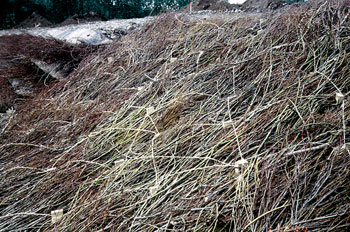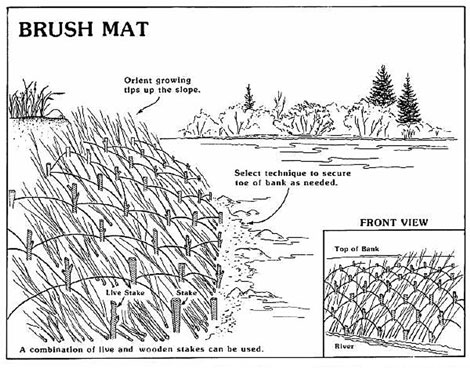Streambank Revegetation and Protection: A Guide for Alaska
Revegetation Techniques: Brush Matting
A brush mat is a revegetation technique that provides a protective vegetative covering to a slope as soon as it is installed. A brush mat can be constructed with dormant branches that will root and grow (see Plant Species Selection List, Shrubs and Trees) and is often combined with other revegetation and/or protection techniques which are used to secure the toe of the slope including root wads, live siltation, bundles, coir logs and spruce tree revetments.
A brush mat is recommended over an erosion control mat without vegetation because it provides erosion control while also providing quality fish and wildlife habitat. The brush mat may grow and provide plant cover, and the small pockets created by the overlapping branches will trap native seeds and provide an environment for germination and growth. During high water, a brush mat may trap sediments and eventually the plant growth on the stabilized streambank will provide fish habitat. If the original bank is denuded of vegetation and the soil is compacted, be sure to scarify the bank and deposit soil before installing brush mat. Additional toe-of-slope protection may be necessary.


Collection, storage and planting information for a living brush mat are described under Dormant Cuttings in the Plant Care and Preparation section. Brush mats require large quantities of plant materials. The availability of plant material should be carefully evaluated before including this technique in a revegetation design.
Install branches flat on the bank and perpendicular to the stream with branches slightly crisscrossed. The large end of the branch is placed at the toe of the slope. Add branches until the soil surface below the branches is covered. Brush mats can be installed over rooted plants and live stakes that are planted on a slope.
Stake the mat in place with stakes or live stakes and biodegradable twine or rope. Place stakes on 3-foot centers, attach twine around each stake to form a criss-cross pattern, and then drive the stakes into the substrate as deeply as possible pulling the branches tightly against the soil (see Live Staking section). Add a small amount of soil over the mat so that the lowest layer of branches is partially buried to encourage rooting. Water brush mat lightly to compress the added soil; then add more soil if necessary. The completed compressed mat will be approximately 3-4 inches thick. If high water occurs before the brush mat becomes established, the topsoil on the lower portions of the mat may wash away. A light seeding of native grass may help prevent/reduce the loss of topsoil.
Advantages:
- Provides good plant coverage and erosion control
- Promotes good soil stability
- No geotextile or metal left in bank
Disadvantages:
- Labor intensive and may be technically challenging
Consultation with a Streambank Revegetation Specialist before installation of any revegetation or protection technique is necessary to gain site specific information (see Contacts).
